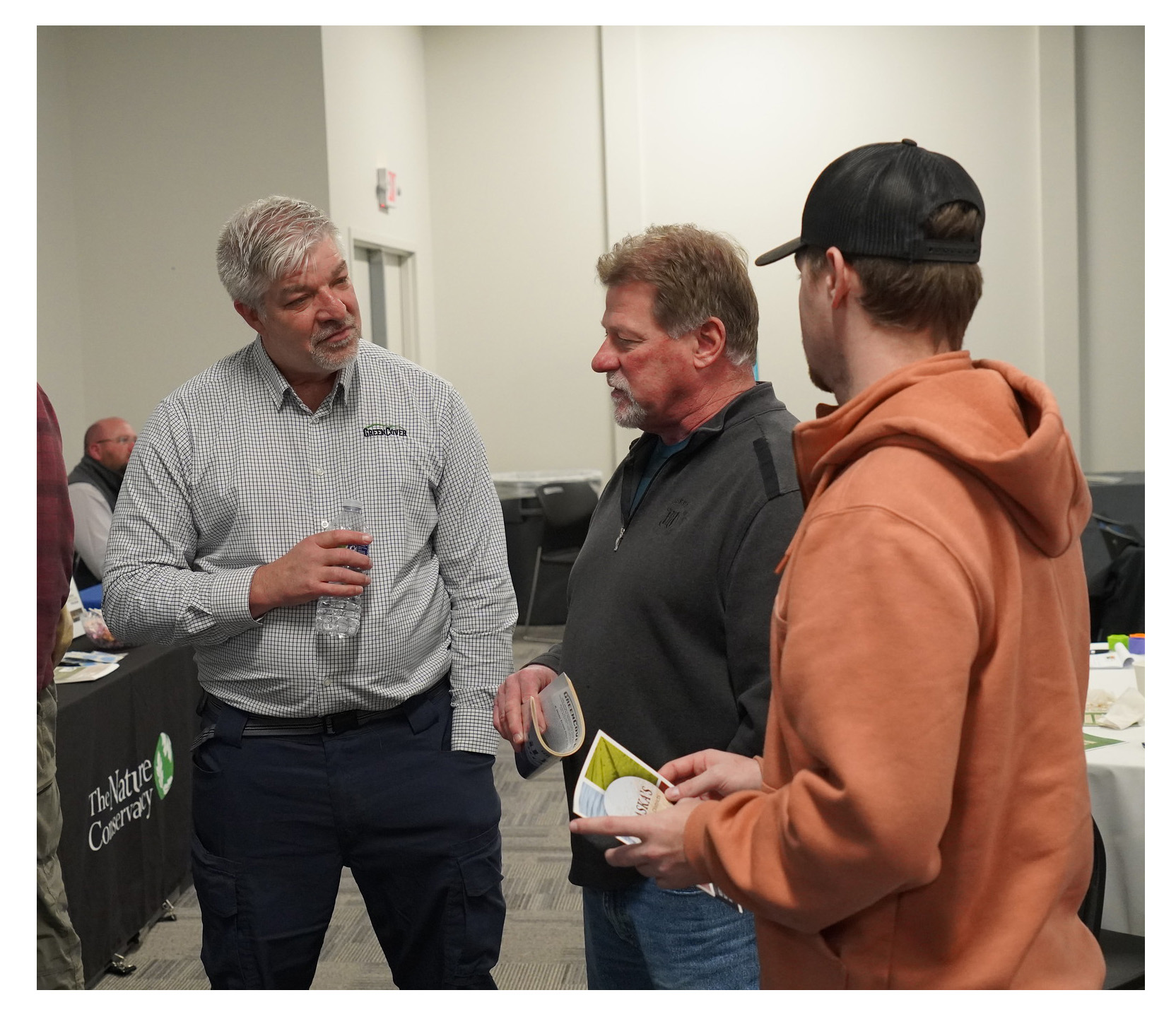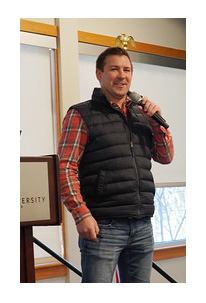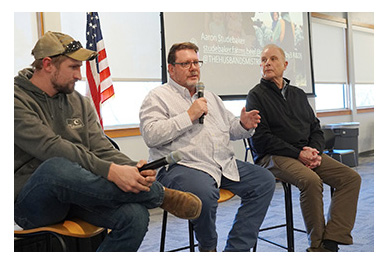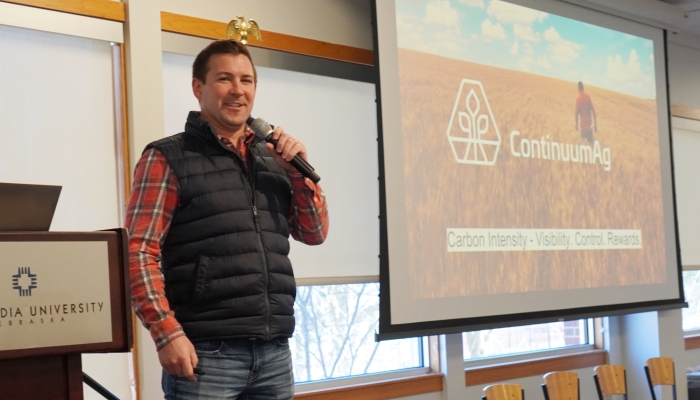From Carbonomics to Carbon Intensity Scoring, Regenerative Agriculture Conference Explores Conservation ROI
Sustainable, regenerative, decarbonized—no matter what you call it, Nebraska’s farmers are increasingly being asked to produce enough food, fuel, and fiber for a growing global population, while reducing their impact on the environment. How do farmers incorporate practices that are proven to be good for the land as well as their bottom line, and what supports are in place to help them make the transition from conventional practices to more sustainable ones?
These questions were the topic of a recent regenerative ag conference held in Seward, Nebraska. More than 300 people attended the event, which was hosted by the Little Blue, Lower Big Blue, Lower Platte South, and Upper Big Blue Natural Resources Districts. The event featured keynote speakers Keith Berns, co-owner of Green Cover Seed, and Mitchell Hora, founder and CEO of Continuum Ag, as well as a local producer panel. The conference drew attendees primarily from the eastern half of Nebraska, but also saw participants from Iowa, Kansas, and Colorado.
Topics covered included soil health, cover crops, no-till, soil microbes, erosion prevention, carbon intensity scores, and potential funding for producers moving from conventional practices to regenerative ones. In addition to the speakers, attendees had time to visit with event sponsors representing a broad spectrum of products and services in the regenerative ag space.
See photos and recorded presentations from the event.
“Carbonomics”
Keith Berns challenged the audience during his introductory keynote address with a thought exercise: Imagine if you went home today to find that half of your land was gone, and you suddenly had to make do with a lot less.
While no one is coming to steal your fields, American farmers are already in this scenario, due to soil degradation. “We’ve lost half of our topsoil from water erosion and wind erosion,” Berns said, showing a dust bowl photo of billowing clouds of soil. “Of the soil that we have left, we’ve lost more than 50 percent of the carbon, the organic matter that’s in our soil,” which leads to a significant decline in soil productivity.

Changing weather patterns with heavier rainfalls punctuated by longer periods of drought make it more essential than ever to have a healthy functioning soil system that can take in and hold moisture, he said. How do we restore the soil to maximum productivity and increase water holding capacity? By treating the soil like a country’s economy. Berns went on to describe in detail “Carbonomics,” the economy of the soil with the currency of carbon.
Plants, animals (soil biota), and the soil each have a distinct role to play in this economy, whether they are producers or consumers. When producers and consumers are balanced and everyone is ‘working’, then you have a ‘low unemployment rate’ and a healthy system. Plants capture sunlight and use it to produce carbon. In that way, a farmer’s success is tied to how well they convert sunlight into something of direct value, like a bushel of soybeans. To improve soil productivity, you must add more carbon into the system via photosynthesis. An easy way to do this is to make sure there is something growing on the soil year-round through the use of cover crops.
When we provide a plant externally with what the soil system should provide for them naturally, you make the soil economy less functional, Berns explained, likening this scenario of increased inputs to “agricultural welfare.” When the soil economy is working, there should be enough nutrients and plant defenses occurring naturally that there isn’t a need for large quantities of fertilizer or herbicides.
“Your biggest energy expense on the farm isn't diesel. It's nitrogen,” Berns told conference attendees. While the atmosphere is full of nitrogen, it isn’t directly accessible to the plants. To access the nitrogen, farmers need to support the “nitrogen factories” in the soil, including legumes as well as soil microbes like azospirillum and azotobacterium.
What kills these nitrogen-fixing microbes?
Products like pesticides, fungicides, herbicides, and strong chemical fertilizers, as well as practices such as excessive tillage or monocropping.
In this way, conventional agricultural practices are reducing the natural nitrogen fixing bacterial activity of the soil.
“Tillage is an act of war on your soil,” explained Berns, as it takes out the transportation and communication infrastructure of the soil.
“There’s a lot going on under our feet out there,” Berns said.
Carbon intensity scoring: the next big thing in ag?
Being able to quantify your carbon score is essential to making regenerative agricultural practices pay.
That was the main message from keynote speaker Mitchell Hora. Hora is a seventh generation Iowa farmer and the founder and CEO of Continuum Ag, which seeks to equip farmers with data about their soil health and quantify the financial return on their soil health investments.

Data equals dollars, Hora told the farmers in the room. You can’t sell what you can’t measure. As financial institutions work toward carbon neutrality, pledging to decarbonize their portfolios, a new opportunity for agriculture is emerging.
Carbon intensity scoring quantifies the carbon footprint per agricultural unit, whether that is per bushel of soy, pound of beef, or gallon of milk. Selling a low carbon commodity is selling a data story, said Hora, who recommended that before a farmer reports any data on their practices, they understand the value of that data and how it will be used.
Changes are already evident in the carbon conversation in the biofuel industry. There's money from the federal government for clean fuel, and so a low carbon intensity score is a new unit of measure for businesses to reduce their carbon footprint. Tax credits for lower carbon intensity fuel will soon be available to ethanol plants. Farmers need to figure out their individual carbon intensity score to understand the value they are providing, and to get a piece of the profits that are coming to businesses.
“Decarbonizing agriculture is a huge opportunity to bring money to middle America,” Hora said. “Farmers will absolutely rise to the occasion to decarbonize, but we want our fair share."
According to the US Department of Energy, the typical bushel of corn has a carbon intensity score around 29g GHG/MJ (greenhouse gas emission per megajoule). However, according to Hora’s calculations, the average farmer’s carbon intensity score in their network is around 11g GHG/MJ. Due to conservation practices including long term use of cover crops and no-till, the Hora Farm’s carbon intensity score is -4.1g GHG/MJ. Buying corn with a lower carbon intensity score will increase the value to the ethanol plant when it comes to future tax credits, worth millions each year. Therefore, products with a lower carbon intensity score will be able to be sold at a premium.
Beyond the future financial windfall from decarbonization that Hora predicts for the agricultural industry, regenerative practices also make sense financially in the near term. “Soil health principles have been marketed wrong. They aren’t just defense against problems like erosion and lost productivity. They are offensive management tools,” he said, noting how reduced tillage and inputs, as well as increasing plant diversity have improved his family’s farm.
Building soil organic matter makes you resilient to unpredictable weather, said Hora. Cover crops will keep your soil alive when you aren't getting rain and will keep your soil from running off the farm when there’s too much rain. A cheap measure of soil health on the Hora farm is that they haven't had to replant a crop due to flooding in ages. Their water infiltration rate is an incredible 4 inches in under 5 minutes.
Hora is a realist. He recognizes that sometimes inputs like anhydrous and Roundup are needed, but they are damaging to the soil system and come with a cost, so they should be used as a last resort. “We are on this journey, and it's a long journey,” he said. Practice changes take patience and humility. He recommends that farmers new to these practices implement them slowly and expect slow results, allowing for flexibility to experiment and make changes over time.
Producer panel insights

One of the highlights of the event was a chance to hear from Nebraska farmers, discussing their implementation of regenerative practices and the lessons they’ve learned through trial and error on their farms.
Dennis Fitzke, who farms near Edgar, reported on how cover crops and no-till pay off in a very dry year. “How much rain did you get? I definitely got it all,” he likes to quip. Mycorrhizal fungi can access water for your crop even when there hasn't been rain, he said.
Fitzke began no-till in 1994 and continued doing it because it made him more money for less work. He joked that he has found a financially successful model of farming that goes like this: no tillage + low inputs + no insurance + no debt = more profit.
Fitzke noted the advice of soil experts who say a farmer should always carry a shovel and a soil probe, because what they need to know is underground. “There’s no silver bullet for profitability,” said Fitzke. You can’t implement one new practice and assume that’s what will make a difference. Instead, it takes a whole systems approach, because each practice works together, cascading, and compounding forward.
Hank McGowan, who farms in McCool Junction, discussed the challenges of changing family systems. He farms with his father, who was initially resistant to adding conservation practices on their acres. McGowan started planting cover crops to provide an additional source of forage for his cattle and soon discovered that the practice had other benefits, including a reduction of erosion on his roughest land. “If you’re a livestock producer, this is a slam dunk,” he said.
McGowan recommended that farmers that want to implement regenerative practices take their worst farm and add cover crops there first, as it is where they would have the least to lose and would potentially see improvements fastest. McGowan also discussed his latest efforts around making compost to increase soil microbial activity.
Aaron Studebaker, who farms near Davey, Nebraska, has been using no-till in some capacity since 2006. He recommends cereal rye as a “bulletproof” cover crop, especially useful for weed suppression. “We are running out of chemical options for weeds,” he said, which is why planting rye as a cover crop or a second cash crop in a double cropping system can be so valuable. Another advantage Studebaker has seen with cover crops is erosion control on tricky contoured fields. Additionally, the harvested rye reduces his need for other feed for his cattle through the winter.
‘We’ve always done it that way’ is a toxic mentality for a farmer, said Studebaker, who recommended making SMART goals: specific, measurable, attainable, relevant, and timely. Once the goals are set, hold yourself accountable. How are you improving year over year? “If you can't measure it, you can't improve it,” he said.

